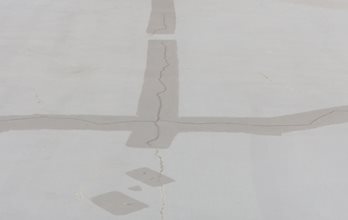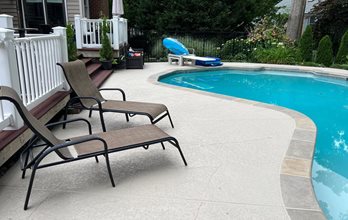
Even concrete, a strong and durable material, can eventually crack. Often, people think they need to replace their entire concrete slab if it has cracks, but fortunately, that’s not the case. In most cases, repairing or resurfacing the concrete is a more affordable and efficient option than replacing.
Get a free quoteLearn more about our concrete repair services.
One of the most obvious reasons for concrete cracking is incorrect installation. This can happen when the concrete wasn’t mixed properly or inadequate control joints. While a well executed installation can prevent lots of problems, even concrete that’s been installed properly can crack over time. Concrete can withstand heavy loads, but it doesn’t have a lot of resistance to bending or stretching.
Not all cracks can be repaired in the same way. The approach you take depends on what caused the cracking and how severe it is. Here are common types of cracks and how they should be addressed.
Caused by natural shrinkage as concrete cures, these types of cracks don’t indicate structural issues. They do need to be repaired to prevent moisture from seeping in.
Solution: Fill with crack filler or adhesive.
These cracks are wider than hairline cracks and appear in random patterns.. They tend to form when the concrete dries too quickly or when too much water is used in the mix.
Solution: Fill with crack filler or adhesive to prevent them from getting bigger. In some cases when shrinkage cracks are significant, resurfacing may be required.
These types of cracks sometimes show up when the ground beneath the concrete isn’t compacted enough. It can also happen if a heavy load is applied to the surface before the concrete fully cures. When you see settlement cracks, you may also see unevenness in the slab.
Solution: Grinding and sealing can sometimes resolve these, though more serious cases need to be resurfaced or replaced.
These are the most serious types of cracks because they are wider and deeper than other types. Structural cracks are often caused by poor reinforcement in the slab, or shifting foundations.
Solution: In some cases, replacing the slab may be the best long-term solution.
To prevent future problems, it’s a good idea to figure out what’s causing your concrete to crack. Whether the cause is environmental factors (e.g., moisture or freeze-thaw cycles) or poor installation, different repair methods are required. If you’re dealing with cracks that are a result of poor reinforcement, you’ll probably need more than just a surface repair. Consult a professional contractor so they can assess the damage and then suggest the most appropriate solution.
Here are a few techniques our contractors use to repair cracked concrete:
 SUNDEK of Washington used Custom Scoreline Effect on this pool deck at a multi-family property.
SUNDEK of Washington used Custom Scoreline Effect on this pool deck at a multi-family property. When you’re dealing with a concrete surface that’s still in good condition structurally, resurfacing is a much more environmentally friendly option. Instead of tearing out the existing slab and disposing of the debris, a contractor can prep the existing surface and add a new layer of material. Taking this approach conserves resources, reduces labor, and minimizes waste.
You can use inexpensive crack fillers to repair small hairline cracks. For more extensive damage, you should consult a professional. To get an accurate estimate of the cost of concrete repair, a professional contractor will need to come assess your surface to determine the size and extent of the damage.
Although minor cracks can be fixed as a DIY project, proper materials and techniques are crucial for lasting repair. If it’s incorrectly done, the crack can return or even get worse. Hiring an experienced contractor ensures a proper and durable repair.
SUNDEK of Washington resurfaces concrete in the major metros in the area, including Arlington, Alexandria, Fairfax, and Reston, Virginia; Bethesda, Frederick, Gaithersburg, and Hagerstown, Maryland; Washington D.C.; and beyond. Contact us today to get started with your project!
Call us at 866-631-8664
Or email us: [email protected]
Get technical information, system guides, and more for all SUNDEK of Washington products.
View the wide range of color options and brochures available through our various systems.
See outstanding SUNDEK projects from contractors across the country.
Useful tips to design and run your projects smoothly.
Find design cut sheets, system guides, tech-app sheets, specifications and more.